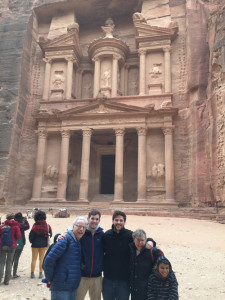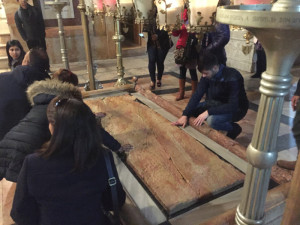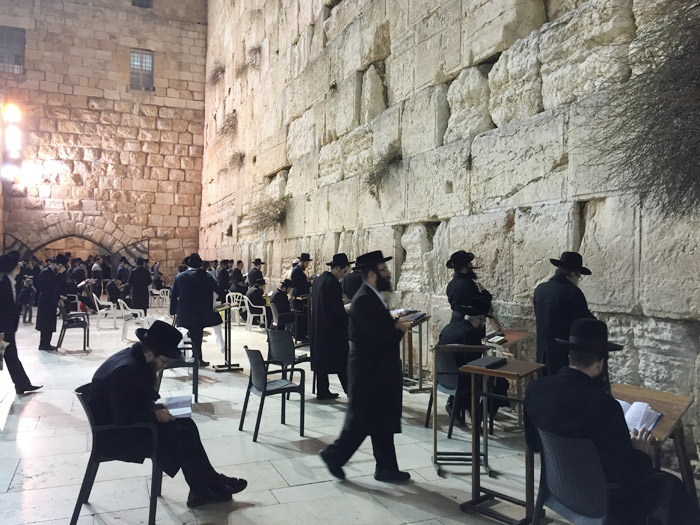By Mark Frost, Chronicle Editor
The Frost family is in the midst of a two-week trip to Israel and Jordan, our first venture into the Middle East.
When our world-traveling 21-year-old son Max first proposed this adventure last fall, I’ll admit to total reluctance that was shared by my wife Sandy. I especially couldn’t see myself, as a Jew, going to Jordan and Palestinian territory.
But bit by bit, as Max mapped an itinerary, the idea of the journey took root. Max used the Internet to find and hire guides. Sandy used it to book hotels and a rental car.
As war and terror surged in the Middle East and a spate of killings kept roiling Israel, Sandy and I still weren’t sure we’d actually go. Over Thanksgiving when we had the family together, we had a serious discussion and voiced conflicting opinions.
In the end, though, we arrived at a consensus: We’re doing this.

Max, in talking to guides, through email and Skype, became convinced that while the dangers are real, they are also blown out of proportion by the media blitz.
A combination of opportunity and urgency motivated me. Opportunity because all four of us were available now and we could swing this financially.
Urgency because Middle East stability is in meltdown and I see Israel’s very survival at increasing risk, all the more with the Left having turned against it too. The trip might be now or never.
Urgency also because I turned 65 in December. How long will Sandy and I be physically up to a trip that has been pretty grueling? We’ve walked about six miles a day, lots of uphill sections. Did I say we slept in a tent in a Bedouin resort carved out of the desert in Jordan?
An urgency, too, to see first-hand a part of the world that is cradle to our civilization and dominates current events — our chance to delve into the history, culture, politics, geology, religion, food, archaeology and individual people of this encompassing place we’d never been.
So many presumptions are made about it; there is no substitute for going there ourselves with an open mind.
And then to do it as a whole family — intense, shared experience we’ll reference for the rest of our lives.
At the desert camp we started talking to a group of young Jordanians who were great fun. By the end, they and Max and Alexander were Facebook friends. I’m sure they’ll be in touch. We’ll be part of that relationship.
We’ve gotten to know well the Israeli guides we hired, and we peppered them with every question we could think of. We’ve interacted with countless other people, often memorably.
In Jerusalem we walked the Via Dolorosa, the path Jesus climbed hauling the cross on which he was crucified. We went through the Church of the Holy Sepulcher, where the crucifixion and entombment are said to have occurred.

We joined the prayerful at Judaism’s hoiest site, the 2,000-year-old Western Wall that survived the Romans’ destruction of the Second Temple in 70 AD. The Western Wall brings worshippers nearest to what was the Temple Mount, seen as the keystone of life itself.
What stands atop the mount now is Islam’s Dome of the Rock, from which Muslims believe the prophet Mohammed ascended to heaven.
It is a place of fierce tensions. A profusion of Israeli soldiers and police patrol across the plaza, assault rifles at the ready.
In Jordan, Bedouins guided us through the stunning narrow canyon and elaborate carved sandstone of Petra, thousands of years old and considered one of the seven man-made wonders of the world, along with such sites as the Taj Mahal and Great Wall of China.
The next day Bedouins drove us on the back of Toyota pick-ups into the Wadi Rum desert where the movies Lawrence of Arabia and The Martian were filmed.
In Israel’s Golan Heights atop Mount Bental we looked across to Syria only a mile away. We heard artillery shelling and small arms fire and saw how strategically crucial the Golan is and why Israel annexed it after the Syrian tank invasion that ended in Israel’s victory against enormous odds in the 1973 Yom Kippur War.
We reached the Red Sea and saw across to Israel and Egypt, and on to the Saudi Arabia mountains in the distance.
We drove on highways through what non-Israelis call the Occupied Territories.
In Nazareth we visited the grotto where the Virgin Mary is said to have lived and been told by the Angel Gabriel that she would give birth to the son of God. We went to the hilltop where Jesus delivered his Sermon on the Mount (“blessed are the poor…”).
We were at the Sea of Galilee, which is actually a freshwater lake more on the scale of our own Sacandaga. At the Galilee, the Bible says Jesus walked on water and miraculously made five loaves and two fishes suffice to feed a crowd of thousands of his followers.
On the Mediterranean coast, we explored the alleyways of the predominantly Arab town of Akko, within sight of Lebanon, and we went inside the Al Jazaar mosque — whose claim to fame includes possession of a lock of hair from Mohammed’s beard, though it’s not on view.
In Jaffa, adjacent to Tel Aviv and the Mediterranean Sea, we walked what is thought to be the world’s oldest port, from which Jonah sailed and was famously swallowed by a whale.
That’s the tip of the iceberg. We are having a surpassing adventure, still with some days to go. As I write these words, it is Monday at 5:47 a.m. Israeli time. We’re due back in the U.S. on Thursday, Jan. 14.
We’ll come away with a wealth of journalistic material — photos, notes, quotes, thoughts, impressions, and videos for our Facebook page and website — that we’ll mine for months to come.
We aim to make Chronicle readers feel as if you were with us exploring Israel and Jordan, hopefully sweeping you up in the discovery, revelation and exhilaration that is making this two of the greatest weeks of our lives.

Copyright © 2016 Lone Oak Publishing Co., Inc. All Rights Reserved.
 Glens Falls Chronicle Serving the Glens Falls/Lake George region; Warren, Washington and northern Saratoga counties since 1980
Glens Falls Chronicle Serving the Glens Falls/Lake George region; Warren, Washington and northern Saratoga counties since 1980


